SHIMOJO Masumi (下条 圭美)
Solar physicist
Jets in the Solar Atmosphere
Prototype of explosions in the solar atmosphere

Jets in the Solar Atmosphere
I have been trying to understand the release of magnetic energy in the solar atmosphere since I was an undergraduate student. Although it is well known that dynamic phenomena in the solar atmosphere are driven mainly by “magnetic reconnection,” it cannot explain everything. To fully explain these phenomena, we need to understand how magnetic energy is converted into thermal energy, plasma kinetic energy, and non-thermal-particle kinetic energy. To achieve my scientific goal, I am investigating jet phenomena in the solar atmosphere based on the observing data with a broad wavelength range, from radio to X-rays.
- X-ray jets in the north polar region
observed with with the X-ray Telescope aboard Hinode satellite - Recent refereed papers (as a coresponding author)
- Shimojo et al. 2020, Astrophysical Journal Letters, 888, L28
"Estimating the temperature and density of a spicule from 100 GHz data obtained with ALMA" - Shimojo et al. 2017, Astrophysical Journal Letters, 841, L5
"The First ALMA Observation of a Solar Plasmoid Ejection from an X-Ray Bright Point" - Shimojo & Tsuneta 2009, Astrophysical Journal Letters, 706, p. L145
"The Relation Between Magnetic Fields and Coronal Activities in the Polar Coronal Hole"
- Shimojo et al. 2020, Astrophysical Journal Letters, 888, L28
- Review paper (as a co-author)
- Raouafi, et al. 2016, Space Science Reviews , 201, p. 1
Solar Coronal Jets: Observations, Theory, and Modeling
- Raouafi, et al. 2016, Space Science Reviews , 201, p. 1
- Scientific article written in Japanese (解説記事)
-
ひのでX線望遠鏡が見た太陽X線ジェット
The Astronomical Herald, Jun. 2008
-
ひのでX線望遠鏡が見た太陽X線ジェット
Solar Cycle
Why do sunspots change periodically?
Image Credit: NAOJ/ISAS
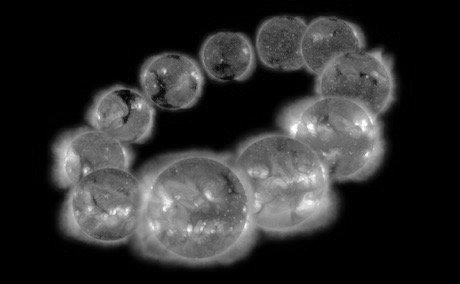
Observational Studies of Solar Cycle
The number of sunspots changes periodically, and its period is about 11 years. The fact is well known since the 18th century, but we cannot answer the question "Why sunspots change periodically?" yet. To solve the problem and understand the periodical variation of the solar atmosphere, I'm studying solar-cycle issues observationally, especially using solar radio data.
- Butterfly diagram created from the sites of the prominence eruptions
observd with Nobeyama Radioheliograph (17 GHz)
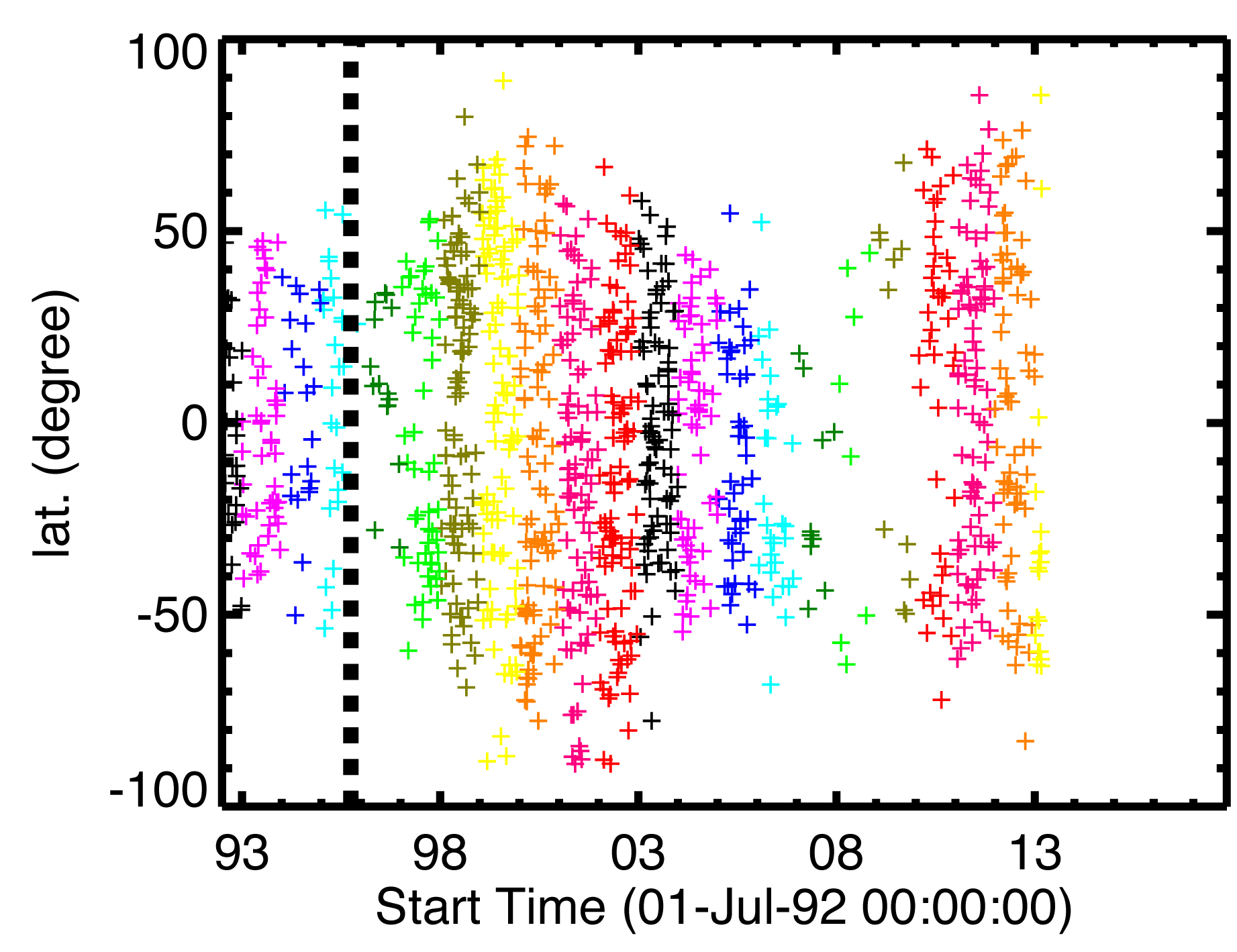
- Recent refereed papers (as a corresponding author)
- Shimojo et al. 2024, Astrophysical Journal, 965, 170
"Comparison of solar multifrequency microwave data with other solar indices for understanding solar and stellar microwave data" - Shimojo et al. 2017, Astrophysical Journal, 848, 62
"Variation of Solar Microwave Spectrum in the Last Half Century" - Shimojo 2013, Publications of the Astronomical Society of Japan, 65, S16
"Unusual Migration of Prominence Activities in the Southern Hemisphere during Cycles 23-24"
- Shimojo et al. 2024, Astrophysical Journal, 965, 170
- Scientific article written in Japanese (解説記事)
-
プロミネンス活動でみる太陽周期
The Astronomical Herald, Aug. 2014
-
プロミネンス活動でみる太陽周期
- Press Release
Solar Observations with ALMA
Development of solar observing method with ALMA

Solar Observations with ALMA
The Atacama Large Millimeter/submillimeter Array (ALMA) is the largest radio interferometer in the world for observing the celestial objects, mainly star formation region, high-z galaxy, molecular cloud. ALMA has a capacity of observing the Sun too, but the development of solar observations had not been done until 2010. We developed the solar observing method with Band3 (100 GHz) and Band6 (239 GHz) and started to offer solar observations to scientists in 2016. The development is continued for adding new functions of observing the Sun.
- Sunspot Observed with ALMA
From Left: ALMA 239 GHz, SDO/AIA WL , SDO/AIA WL(Full Sun)

- Reference Papers
- Shimojo et al. 2017, Solar Physics, 292, 87
"Observing the Sun with the Atacama Large Millimeter/submillimeter Array (ALMA): High-Resolution Interferometric Imaging"
- White et al. 2017, Solar Physics, 292, 88 "Observing the Sun with the Atacama Large Millimeter/submillimeter Array (ALMA): Fast-Scan Single-Dish Mapping"(as a co-author)
- Shimojo et al. 2017, Solar Physics, 292, 87
- Shimojo et al. 2024, Solar Physics, 299,20
"Observing the Sun with the Atacama Large Millimeter/submillimeter Array (ALMA): Polarization Observations at 3 mm"
- Bastian, et al. 2022, Frontiers in Astronomy and Space Sciences, 9:977368
Solar Observing with the Atacama Large Millimeter-Submillimeter Array - Nindos, et al. 2022, Frontiers in Astronomy and Space Sciences, 9:981205
The dynamic chromosphere at millimeter wavelengths - Wedemeyer, et al. 2016, Space Science Reviews , 200, p. 1
Solar Science with the Atacama Large Millimeter/Submillimeter Array — A New View of Our Sun
-
アルマ望遠鏡による太陽観測
The Astronomical Herald, May 2018
Nobeyama Radio Polarimeters
The radio telescopes for measuring solar fluxes with multiple frequencies in microwave range
Image Credit: NAOJ

Nobeyama Radio Polarimeters (NoRP)
Nobeyama Radio Polarimeters (NoRP) are observing the Sun with multiple frequencies in the microwave range. It is capable to obtain the total coming flux and the circular-polarization degree. The system of 17 GHz is routinely working since 1978, that of 35 GHz since 1983, and that of 80 GHz since 1984. The systems of 1, 2, 3.75, and 9.4 GHz were working at Toyokawa observatory of the Research Institute of Atmospherics, Nagoya University since the 1950s. They were moved to Nobeyama in Apr 1994 and has been working since then. I have been contributing to the operation of NoRP as a manager since 2019.
- Solar Cycle in Microwave (1951 - 2023)
Blue: 1 GHz, Red: 2GHz, Orange: 3.75 GHz, Green 9.4 GHz,
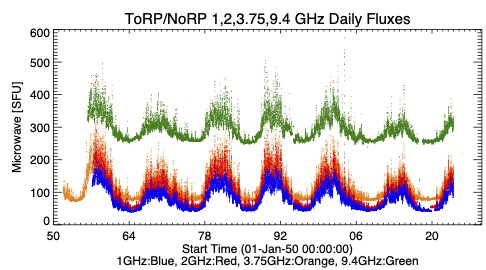
- Reference Paper
- Shimojo and Iwai 2023, Geoscience Data Journal, 10, 114–129
"Over seven decades of solar microwave data obtained with Toyokawa and Nobeyama Radio Polarimeters"
- Shimojo and Iwai 2023, Geoscience Data Journal, 10, 114–129
- Link: Nobeyama Radio Polarimeters (NoRP)
"Hinode" Satellite (SOLAR-B)
The microscope for the Sun
Image Credit: NAOJ
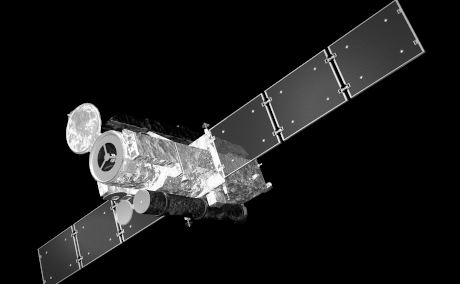
"Hinode" Satellite (SOLAR-B)
The solar observing satellite “Hinode” was launched from Uchinoura Space Center on September 23, 2006 (JST). “Hinode” has three telescopes to observe the Sun. The cylindrical main body of the satellite is the Solar Optical Telescope (SOT) which observes in visible light. The cylinder attached beneath the main body is the X-Ray Telescope (XRT). The Extreme-ultraviolet Imaging Spectrometer (EIS) is mounted to the upper surface of the main body. These innovative telescopes can capture the movement of the complex solar magnetic fields and the three-dimensional motions of the plasma in real time.
I joined the Hinode project in 1999 and had contributed the development of the X-Ray Telescope (XRT), Attitude Control System, Mission Operation and Data Analysis (MODA) and the establishing of Hinode Science Center at NAOJ. After launching "Hinode", I have been contributing to Public Outreach (2006 - 2013) and XRT Scientific Operation (2006 - present).
- X-Ray Sun observed with Hinode/XRT
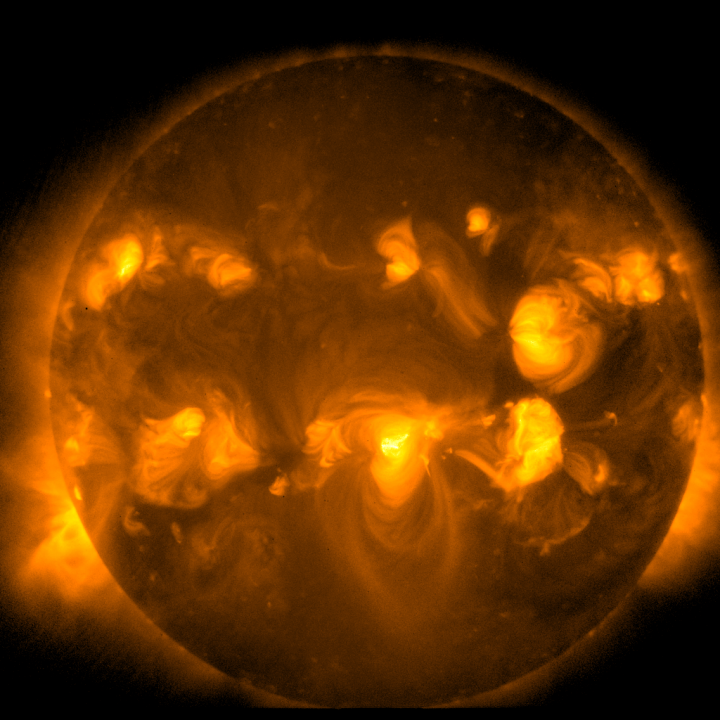
- Reference Papers (as a co-author)
- Kosugi et al. 2007, Solar Physics, 243, 3
"The Hinode (Solar-B) Mission: An Overview" - Golub et al. 2007, Solar Physics, 243, 63
"The X-Ray Telescope (XRT) for the Hinode Mission" - Matsuzaki et al. 2007, Solar Physics, 243, 87
"Data Archive of the Hinode Mission" - Kano et al. 2008, Solar Physics, 249, 263
"The Hinode X-Ray Telescope (XRT): Camera Design, Performance and Operations" - Narukage et al. 2011, Solar Physics, 269, 169
"Coronal-Temperature-Diagnostic Capability of the Hinode/X-Ray Telescope Based on Self-Consistent Calibration" - Narukage et al. 2014, Solar Physics, 289, 1029
"Coronal-Temperature-Diagnostic Capability of the Hinode/X-Ray Telescope Based on Self-consistent Calibration. II. Calibration with On-Orbit Data"
- Kosugi et al. 2007, Solar Physics, 243, 3
- Review Paper (as a co-author)
- Hinode Review Team, et al. 2019, Publications of the Astronomical Society of Japan, 71, R1
Achievements of Hinode in the First Eleven Years
- Hinode Review Team, et al. 2019, Publications of the Astronomical Society of Japan, 71, R1
- Articles written in Japanese (解説記事)
-
「ひので」衛星の広報普及・教育活動
The Astronomical Herald, Sep. 2016 (as a co-author) -
ひのでサイエンスセンター -設立前から今後の課題まで-
The Astronomical Herald, Oct. 2016
-
「ひので」衛星の広報普及・教育活動
- Links
"YOHKOH" Satellite (SOLAR-A)
Observed solar flares and established its magnetic reconnection model
Image Credit: JAXA
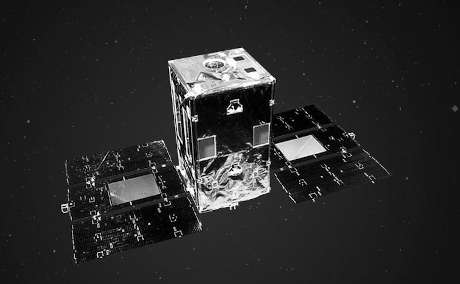
"YOHKOH" Satellite (SOLAR-A)
"Yohkoh" is the 2nd solar observing satellite of Japan and was launched on 30 August 1991 (JST). The satellite's objectives were observations of solar flares during a maximum period of solar activity and revealed the physical mechanism of solar flares.
When I was an undergraduate student, I joined the Yohkoh project and started my career as a solar physics researcher. I investigated mainly solar X-ray jets discovered with Yohkoh satellite (Shibata et al. 1992 and Strong et al. 1992) and got a doctorate in March 1999.
- Final images observed with Soft X-ray Telescope aboard Yohkoh satellite (2001/12/15).
-
My Doctoral Thesis
-
"Studies of Solar Coronal X-ray Jets"
Supervisors: Prof. Kazunari Shibata & Prof. Tetsuya Watanabe
-
"Studies of Solar Coronal X-ray Jets"
- Link: Yohkoh Homepage (written in Japanese)
Solar Data-Analysis Systems
Developments of computer systems for analyzing solar data
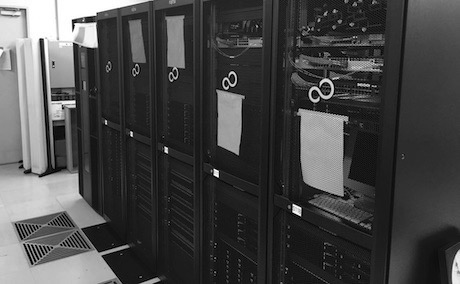
Solar Data-Analysis Systems
For analyzing the solar data obtained with the solar telescopes on the ground and orbit, the computer system that is optimized for solar data-analysis is essential. I have contributed to the development and operation of the computer system for analyzing the data obtained with Hinode satellite, solar radio telescopes at Nobeyama and Yohkoh satellite, since when I was a graduate student.
- Current operated system: Solar Data Archive System (SDAS)
- Articles
-
First Ten Years of Hinode Solar On-Orbit Observatory
2018, Astrophysics and Space Science Library, 449,
[I took chrage of writing Chapter 22.] -
ひのでサイエンスセンター -設立前から今後の課題まで-
The Astronomical Herald, Oct. 2016 - Shimojo & Tsuneta 2007, ASP Conference Series, Vol. 369, p.59
"The Solar-B Science Center in Japan " - Shimojo 2007, ASP Conference Series, Vol. 369, p.31
"Archiving, Distribution and Analysis of Solar-B Data" - Matsuzaki et al. 2007,Solar Physics, 292, 87
"Data Archive of the Hinode Mission"
-
First Ten Years of Hinode Solar On-Orbit Observatory
- Links
Publication
My articles carried on scientific journals
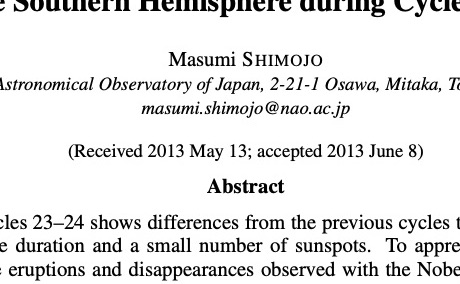
Publication
- Citation Metrics: Go to ADS (Only corresponding-author papers)
- Web of Science ResearcherID: J-2605-2016
- Google Scholar: Masumi Shimojo
- Karadashian(K)-Index: 0.16 on 24 September 2024 (^^;;)
- Recent refereed papers (as a corresponding author)
- Shimojo et al. 2024, Astrophysical Journal, 965, 170
"Comparison of solar multifrequency microwave data with other solar indices for understanding solar and stellar microwave data" - Shimojo et al. 2024, Solar Physics, 299, 20
"Observing the Sun with the Atacama Large Millimeter/submillimeter Array (ALMA): Polarization Observations at 3 mm"
- Shimojo and Iwai 2023, Geoscience Data Journal, 10, 114–129
"Over seven decades of solar microwave data obtained with Toyokawa and Nobeyama Radio Polarimeters"
- Shimojo et al. 2024, Astrophysical Journal, 965, 170
- Review papers (as a co-author)
- Bastian, et al. 2022, Frontiers in Astronomy and Space Sciences, 9:977368
Solar Observing with the Atacama Large Millimeter-Submillimeter Array - Nindos, et al. 2022, Frontiers in Astronomy and Space Sciences, 9:981205
The dynamic chromosphere at millimeter wavelengths - Hinode Review Team, et al. 2019, Publications of the Astronomical Society of Japan, 71, R1
Achievements of Hinode in the First Eleven Years - Raouafi, et al. 2016, Space Science Reviews , 201, p. 1
Solar Coronal Jets: Observations, Theory, and Modeling - Wedemeyer, et al. 2016, Space Science Reviews , 200, p. 1
Solar Science with the Atacama Large Millimeter/Submillimeter Array — A New View of Our Sun
- Bastian, et al. 2022, Frontiers in Astronomy and Space Sciences, 9:977368
- Scientific papers in Japanese (解説記事)
-
アルマ望遠鏡による太陽観測
The Astronomical Herald, May 2018 -
プロミネンス活動でみる太陽周期
The Astronomical Herald, Aug. 2014 -
ひのでX線望遠鏡が見た太陽X線ジェット
The Astronomical Herald, Jun. 2008
-
アルマ望遠鏡による太陽観測
- blog
-
Solar Microwave Polarization Observed by the Newest and Oldest Solar Radio
Telescopes by Masumi Shimojo
CESRA Science Highlights, May 2024
-
Solar Microwave Polarization Observed by the Newest and Oldest Solar Radio
Telescopes by Masumi Shimojo
Teaching Experience
Lectures for graduate/under-graduate students
Supervised students

Teaching Experience
- Lectures for graduate/under-graduate students
- Lecture “Astronomy I and II”
at Faculty of Letters, Keio University (2019 - Present) - Face-2-Face Course "Basic of Observational Astronomy"
at Gunma Study Center, The Open University of Japan
(2019 - Present) - Lecture “Radio Astronomy I” at Astronomical Science Program,
SOKENDAI (2nd Semester, 2023) - Spring School “Solar Physics”
at SOKENDAI/NAOJ (Feb. 2018) - Intensive Course “Basic of Solar Physics”
at Ibaraki University (Jul. 2013) - Intensive Course “Solar Eclipse”
at Tokai University (Jun. 2008) - Intensive Course “Physics of Solar Atmosphere”
at Ibaraki University (May 2008) - Intensive Course “Basic of Solar Physics”
at Shiga University (Dec. 2002)
- Lecture “Astronomy I and II”
- Supervised Students
- Ph.D. Students
Nobuharu Sako, Sep. 2014, The graduate University of Advanced Studies
"Statistical Study of X-ray Jets using Hinode/XRT" - Master Students
Satoshi Kajita, Mar. 2015, Tokai University
"A Study of Non-Thermal Particles before the Impulsive Phase of Solar Flares"
Nobuharu Sako, Mar. 2011, Tokai University
"ひので/XRTの観測データを用いた極域X線ジェットの統計的研究" - Under-graduate Students
Satoshi Kajita, Mar. 2013, Tokai University
"太陽フレアのプリフレア期における硬X線の研究"
Daiki Ishikawa, Mar. 2009, Tokai University
"ひので/SOTで見る太陽北極域の微細磁場構造とエフェメラルリージョン"
Nobuharu Sako, Mar. 2009, Tokai University
"太陽北極域で発生するX線ジェットの統計研究"
- Ph.D. Students
Public Outreach
Lectures and publications for genenal public

Public Outreach
- Lectures for general public
- May 2024
Astronomy Pub at Mitaka Network Univ., Mitaka, Tokyo - May 2021
Lecture at the founding ceremony of Utunomiya-Higashi Junior and Senior High School, Utunomiya, Tochigi - Jan. 2021
Lecture at Asahi Culture Center/Yokohama, OnLine via Zoom - Nov. 2020
Lecture at SOKENDAI/ISAS, OnLine via Zoom - Dec. 2019
Lecture at Bosei Gakujyuku, Musashino, Tokyo - Dec. 2018
Short talk in the UNIVERSE Show at Science Museum, Chiyoda, Tokyo - Oct. 2017
Lecture at 2017 open-day of NAOJ, Mitaka, Tokyo - Sep. 2016
Lectures at Waseda open college (Nakano), Nakano, Tokyo - Jul. 2016
Lectures at Kitakaruizawa-Sundai Astro. Summer School, Naganohara, Gunma - May 2016
Short talk in the UNIVERSE Show at Science Museum, Chiyoda, Tokyo - Jul. 2014
Lecture at Asahi Culture Center/Yokohama, Yokohama, Kanagawa - Mar. 2014
Lecture at University of Shizuoka, Shizuoka, Shizuoka - Apr. 2012:
Lecture at Asahi Culture Center/Yokohama, Yokohama, Kanagawa - Jan. 2010
Lecture at Science Cafe OKAYAMA, Kurashiki, Okayama - Jul. 2009
Lecture at Bosei Gakujyuku, Musasino, Tokyo
- Jul. 2007
Short talk in the UNIVERSE Show at Science Museum, Chiyoda, Tokyo - Jun. 2006
Lecture at Suginami Science Museum, Suginami, Tokyo
- May 2024
- Lectures in elementary/junior-high schools
organized by FUREAI-TENMON-GAKU- Oct. 2025
Lecture at Toride Elementary School, Edogawa Gakuen, Toride, Ibaraki - Nov. 2024
Lecture at Tokyo Metropolitan Mitaka Secondary School, Mitaka, Tokyo - Nov. 2024
Lecture at Shinjuku Elementary School, Kawagoe, Saitama - Jan. 2024
Lecture at Tendai Elementary School, Ayase, Kanagawa - Dec. 2023
Lecture at Tochigi Night Junior High School, Utunomiya Tochigi - Jan. 2023
Lecture at MEISEI Junior and Senior High School , Fuchu, Tokyo - Nov. 2022
Lecture at Moegino Elementary School , Yokohama, Kanagawa - Dec. 2021
Lecture at Yamauchi Junior High School , Yokohama, Kanagawa - Nov. 2021
Lecture at Tokai University Sagami Junior & Senior High School , Sagamihara, Kanagawa - Nov. 2019
Lecture at Ohshima Elementary School, Koriyama, Fukushima - Nov. 2019
Lecture at MITA International School, Setagaya, Tokyo - Dec. 2018
Lecture at Hachiouji Sanda Elementary School, Hachiouji, Tokyo - Nov. 2018
Lecture at Sugatagawa Dai-ichi Elementary School, Utunomiya, Tochigi - Nov. 2017
Lecture at Hadano Minami Junior High School, Hadano, Kanagawa - Sep. 2017
Lecture at Yono-Hommachi Elementary School, Saitama, Saitama - Oct. 2016
Lecture at Ohnohara Elementary School, Yamato, Kanagawa - Oct. 2015
Lecture at Chofu-Otsuka Elementary School, Ota, Tokyo - Oct. 2015
Lecture at Mejiro Elementary School, Toshima, Tokyo
- Oct. 2025
- Publications for general public
- 文藝春秋5月号「同級生交歓」
(文芸春秋社), 2020 -
「We are 宇宙兄弟 宇宙を舞台に活躍する人たち」
(講談社+α新書), 2012 -
「皆既日食と宇宙のふしぎ―“謎”がいっぱいの宇宙を知ろう!」
(SAKURA・MOOK 66), 2009 - ひのでが拓く天文広報活動 SOKENDAI Journal, 2009, Vol. 16
- 文藝春秋5月号「同級生交歓」
Affiliation
ALMA project,
National Astronomical Observatory of Japan,
National Institute of Natural Science
Concurrent appointment in NAOJ
- Solar Science Observatory
- Astronomy Data Center
Academic & Professional Experience
- Dec. 2019 - Present: Associate Professor
ALMA Project, NAOJ/NINS - Apr. 2019 - Present: Part-time Lecturer
Faculty of Letters, Keio University - Apr. 2015 - Nov. 2019: Assistant Professor
ALMA Project, NAOJ/NINS - Apr. 2005 - Mar. 2015: Assistant Professor
Nobeyama Solar Radio Observatory, NAOJ/NINS - Apr. 2004 - Mar. 2005: Research Fellow
Nobeyama Solar Radio Observatory, NAOJ/NINS - Apr. 2000 - Mar. 2004: Assistant
Nobeyama Solar Radio Observatory, NAOJ/NINS - Apr. 1999 - Mar. 2000: Postdoctoral Fellow
YOHKOH Satellite Project, ISAS/JAXA
Education
- Mar. 1999 : Ph.D. in Astrophysics,
The Graduate University for Advanced Studies, Tokyo, Japan
Doctoral Thesis "Studies of Solar Coronal X-ray Jets"
Supervisors: Prof. Kazunari Shibata & Prof. Tetsuya Watanabe - Mar. 1996 : M.S. in Physics, Tokai University, Kanagawa, Japan
- Mar. 1994 : B.S. in Physics, Tokai University, Kanagawa, Japan
- Mar. 1990 : Utsunominya-Higashi High School, Tochigi, Japan
Award
- Feb. 2020: 5th Asia-Pacific Solar Physics Meeting at Pune, India
Young Career Award, Runners-up
Professional Affiliations
International Astronomical Union / Astronomical Society of Japan / American Geophysical Union / Japan Geoscience Union / Japan Solar Physics Community / Japan Radio Astronomy Forum
Journal Referee
Nature Astronomy / Science / Astrophysical Journal / Astronomy & Astrophysics / Monthly Notices of the Royal Astronomical Society / Solar Physics / Publication of the Astronmical Society of Japan/ Journal of Atmospheric and Solar-Terrestrial Physics
Guest Editor
- The Sun Seen with the Atacama Large mm and sub-mm Array (ALMA) - First Results, Frontiers in Astronomy and Space Sciences
Committee services
- Sep. 2024 - Present
President, Commission E3, Division E,
International Astronomical Union - Jun. 2024 - Present
Board member, Space and Planetary Sciences Section,
Japan Geoscience Union - Dec. 2023 - Present
President, Japan Solar Physics Community - Aug. 2018 - Present
Commission E3, Division E, International Astronomical Union - Dec. 2017 - Present
Steering Committee of Japan Solar Physics Community - Aug. 2021 - Aug. 2024
Vice-President, Commission E3, Division E,
International Astronomical Union - Dec. 2021 - Nov. 2023
Vice-President, Japan Solar Physics Community - Apr.2012 - Jun. 2018
Advisory Committee for Solar and Plasma Astrophysics, NAOJ - Apr. 2012 - Mar. 2016
Advisory Committee for Astronomy Data, NAOJ - Apr. 2011 - Mar. 2015
Consortium for Science Operation of Nobeyama Radioheliograph, NAOJ - Oct. 2002 - Sep. 2004
Executive Committee of General Meetings, Astronomical Society of Japan

- Postal Address
ALMA project, National Astronomical Observatory of Japan
2-21-1, Osawa, Mitaka, Tokyo, 181-8588, Japan - Email Address: masumi.shimojo@nao.ac.jp
- ORCID: 0000-0002-2350-3749
- IAU Member Directory: Masumi Shimojo
- KAKEN Researcher#: 00332164
- researchmap.jp: SHIMOJO Masumi